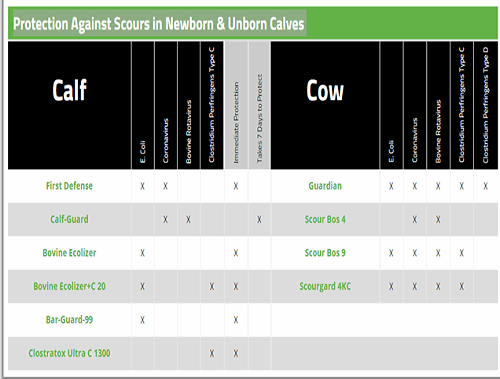2) Cows (Annual revaccination)
If using:
- Scour Bos®9 –Administer during the last part of December (Christmas) to first of January
- Guardian®-Administer between end of December and mid-January
- ScourGuard® 4KC-Administer between mid-January and first week of February
If the cow herd is not vaccinated and calf scours develop, there are vaccines available to administer to newborn calves. These vaccines are given by mouth as quickly as possible after birth, preferably prior to nursing and definitely within the first 12 hours of life. These will provide some immediate protection in the gut but are not nearly as effective as vaccinating the pregnant cows. As seen in Table 2, none of the products for calves protects against all 4 major pathogens ( E.coli K99, rotavirus, coronavirus and Clostridium perfringens Type C).

Table 2: A comparison of scours vaccines given to the calf at birth versus scours vaccines given to pregnant cows
Preventing calf scours involves more than jump starting the immune system of a newborn calf. Excellent cow nutrition during and after gestation, an easy calving process, and environmental management factors all contribute to a successful start. On the flip side, an inadequate quantity and/or quality of colostrum, difficulty calving, poor sanitation, cold, wet weather and overcrowding in calving areas all contribute to a higher risk of disease. Once the calf has received colostrum from the dam, it is still important to prevent the “bad bugs” (pathogens) in the environment from overwhelming the calf’s immune system. Generally, calf scour pathogens build up in the environment as the calving season progresses. Calving in the same area that older calves are in greatly increases the risk to the newborn calf, especially in wet or muddy conditions as we often see in the spring in KY. If possible, pregnant cows close to calving should be rotated onto clean pastures while cow-calf pairs remain on the old pasture. If calving in a barn or shed, the calving area should be kept as clean and dry as possible with frequent changes of bedding to remove the build-up of organisms. Make every effort to get the cow and newborn calf out of the barn quickly to lessen the chances of infection. Even the best calving management practices will have no effect if the first thing a calf ingests is manure from the calving area. Consult with your veterinarian on the best choice of vaccines for your operation.
The UK Veterinary Diagnostic Laboratory has an excellent test to diagnose the cause of calf diarrhea. A small sample of scours (in a leakproof container) from a calf that has not been treated for diarrhea with antibiotics is needed to run the test. This PCR assay tests for bovine coronavirus, rotavirus, E. coli K99, Salmonella and Cryptosporidium. The test is run on Tuesdays and Thursdays with results generally available within 2 days and costs $60 ($50 + $10 Accession Fee).
Source: osu.edu